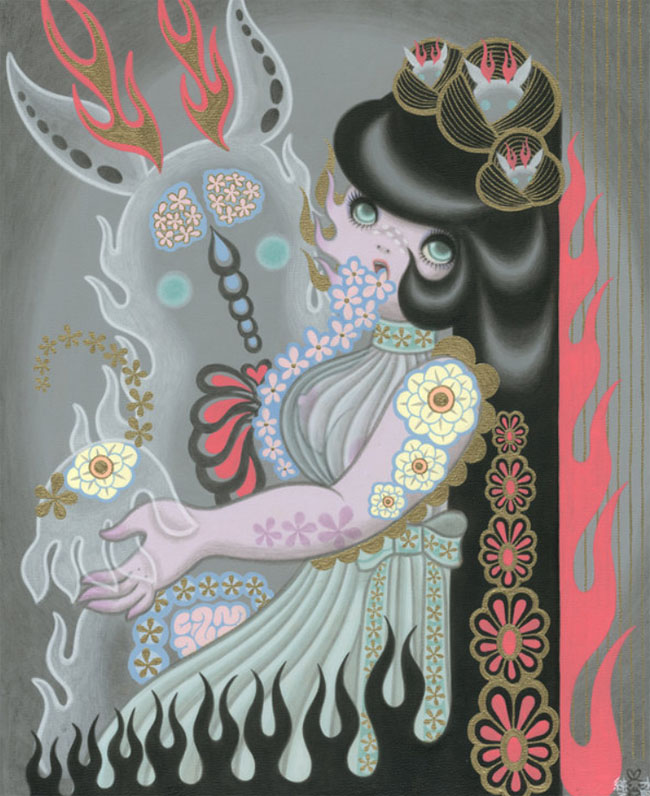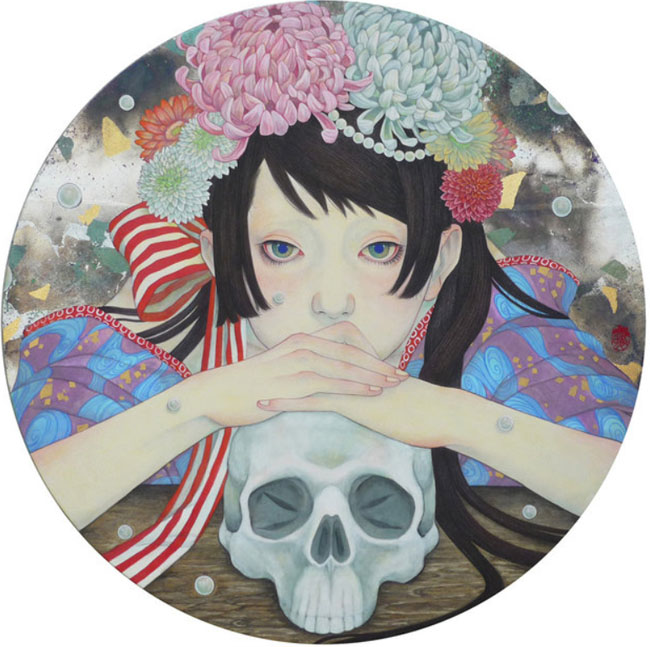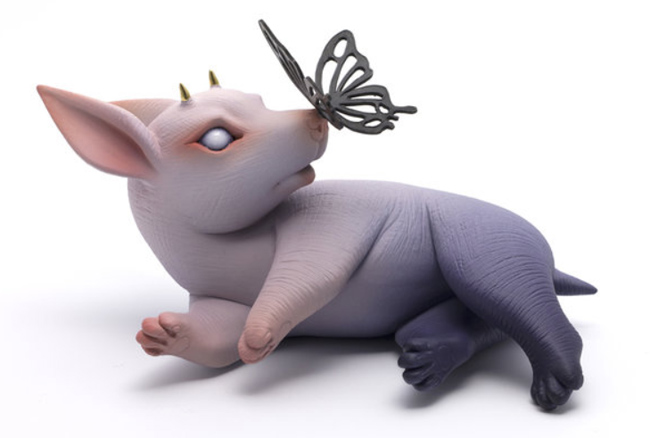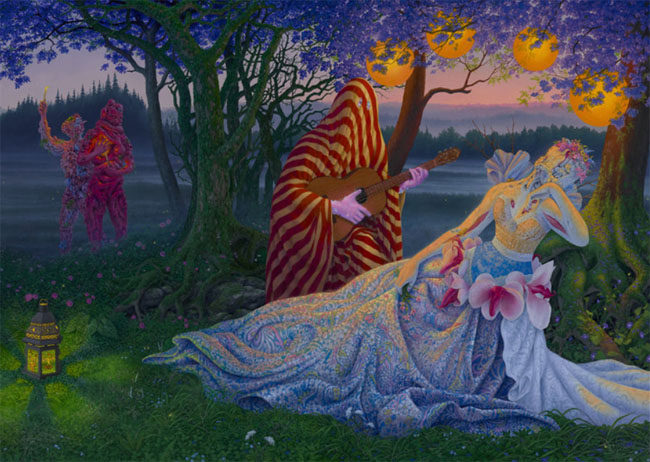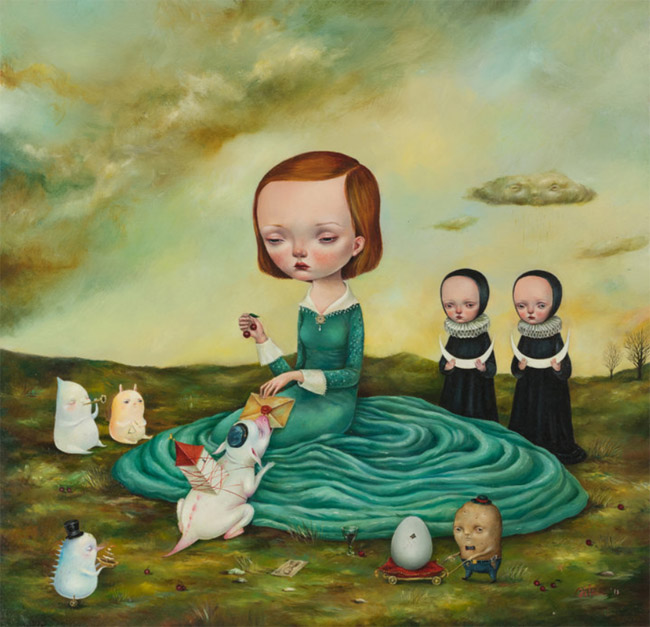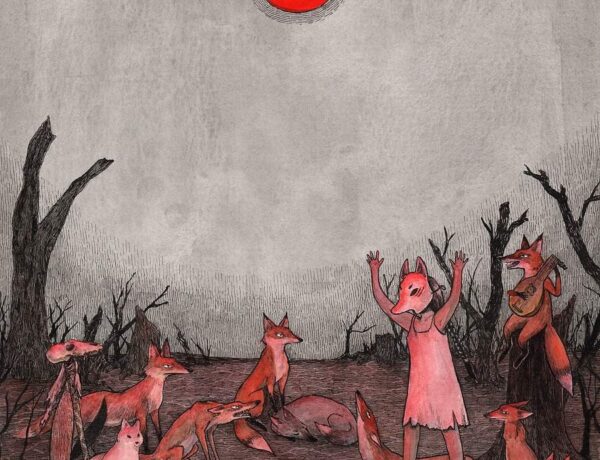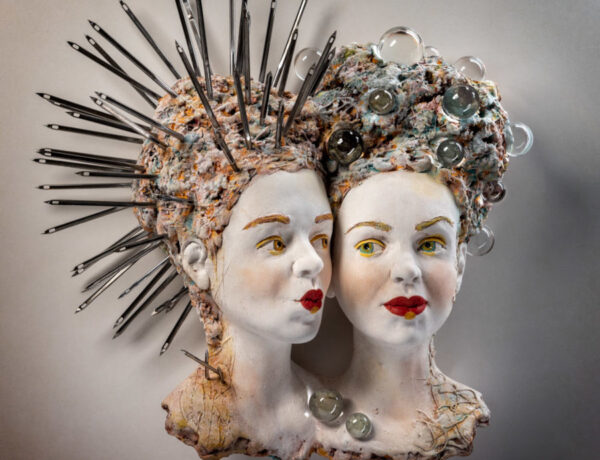Corey Helford Gallery in LA opened three exciting new shows on July 28th. Jasmine Becket-Griffith’s solo show Magical Thinking, Zoe Byland’s solo, Presence of the Past and The New Romantics, a group show curated by Caro Buermann. The New Romantics brings together the works of thirty international artists.
Curation is an art. It requires vision, a passion for art in all its forms and an incredibly wide and deep knowledge current trends and artists. Corey Helford has dovetailed three shows that resonate against each other without reiterating the same ideas and this is not a mere accident of scheduling. Caro Buermann is a Los Angeles based art curator and writer, specializing in Japanese contemporary art. As Special Projects Curator of Corey Helford Gallery in Los Angeles, Caro helps define the gallery’s growing program of artists and has curated numerous notable exhibitions. She most recently organized a major mid-career survey of painter Hikari Shimoda for the Asahi Art Museum in Nagano, Japan. Her writing is regularly published in contemporary art magazine, Hi-Fructose.
In the week leading up to the opening of the shows I talked to Caro Buermann about The New Romantics exhibition and about her role as Special Projects Curator at Corey Helford Gallery.
Participating Artists: Adrian Cox, Akiko Ijichi, Annie Stegg Gerard, Bao Pham, Camilla d’Errico, Carrie Pearce, Dilka Bear, Erika Sanada, Hannah Yata, Happy D, Iva Troj, Jana Brike, Joanne Nam, Junko Mizuno, Kelogsloops, Lu Cong, Mandy Cao, Marie Larkin, Meredith Marsone, Miho Hirano, Naoto Hattori, Nathalia Fabia, Natalia Suellen, Pruch Sintunava, Relm, Sarah Dolby, Shiori Matsumoto, Yuka Sukama, Yumiko Kayukawa.
The New Romantics
Exhibition Dates:
28 July – 1 September 2018
Corey Helford Gallery
571 S Anderson St
Los Angeles, CA
Hours: Tuesday-Saturday: noon to 6pm
Joanne Nam
How would you describe New Romanticism or Neo Romanticism?
Romanticist art was characterized by its emphasis on emotion as well as its glorification of the past and nature. I don’t think that description has changed and those ideas persist in this new generation of artists. It encompasses all forms of art and movements. We’re looking at it through the lens of New contemporary artists we show here at the gallery. They are translating their own experiences and interpretations of the world today into their work and that is what makes it new. I like curating exhibits that have a central theme but can be expanded to suit lots of styles and narratives.

Marie Larkin
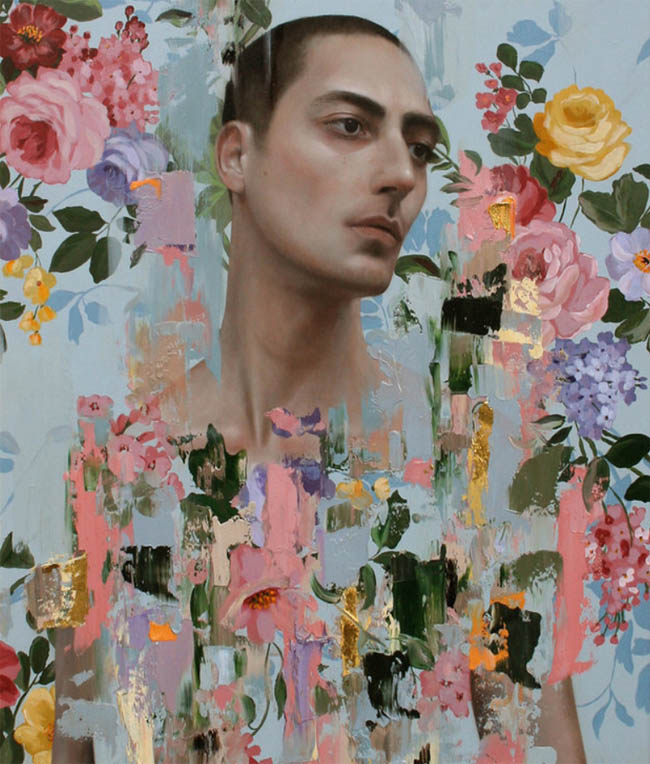
Meredith Marsone

Kelogsloops
What does it have in common in terms of style and content with Romanticism? How does it differ? How do you define or describe the ‘Romantic spirit’?
I like to offer examples to let the artists know where my headspace is at and one example given was Waterhouse who had a passion for nature and love of strong and beautiful figures. Romanticists like Waterhouse portrayed humans at one with nature; others drew nature’s power, evoking a feeling of the sublime. They longed to belong to a society where life seemed so much simpler and beautiful. Neo-romanticism was actually coined in the late 19th century, so jumping ahead to 2018, we are already beyond that. Our ideas about what is beautiful have changed over time, that’s inevitable, but many of us still have that longing – and that’s very romantic.
Iva Troj
Do you think it is a trending genre or style in contemporary art?
I think Neo-Romanticism certainly has a place in this Pop Surrealism/New Contemporary world, it’s just not a term we hear as often and maybe there is a better term we could be using for it. I thought the “New romantics” was more catchy and rolled off the tongue. I don’t think that artists will ever stop looking for an escape in their work. That will never go out of style.
What kinds of artists are leaning into the style?
There are 30 artists in the exhibit and they are ranging all different styles and mediums. Some are more abstract and colorful than others, some are working primarily in painting or sculpture. For example, Chloe Early painted a beautiful portrait of a female figure in her signature flourishes of drippy paint and then we have Junko Mizuno, whose sexy characters are inspired by Japanese comics. There were some artists who I would have loved to see in the show but couldn’t for one reason or another, like Martin Wittfooth or Hikari Shimoda. They all have different ideas about what is romantic, some find it in the divine, others are more transcendental, and that is the point.
Chloe Early
Junko Mizuno
What prompted you to curate The New Romantics show?
Without getting too political, I will say that Romanticism is an idea that grew as an escape from modern society and this show is no different. Urbanization brought on nostalgia for nature and artists were creating images as an allegory for their desire for political change. America is having a turbulent year politically, climate change is happening in real time with the global heat wave, California is burning right now before our eyes, and technology is now a daily part of our lives where we’re constantly staring into a screen. The flood of bad news and bombardment of images makes people long for safe places. I wanted to showcase how our artists are responding beyond the “Trump portrait” and bring the audience to a safe place.

Annie Stegg Gerard
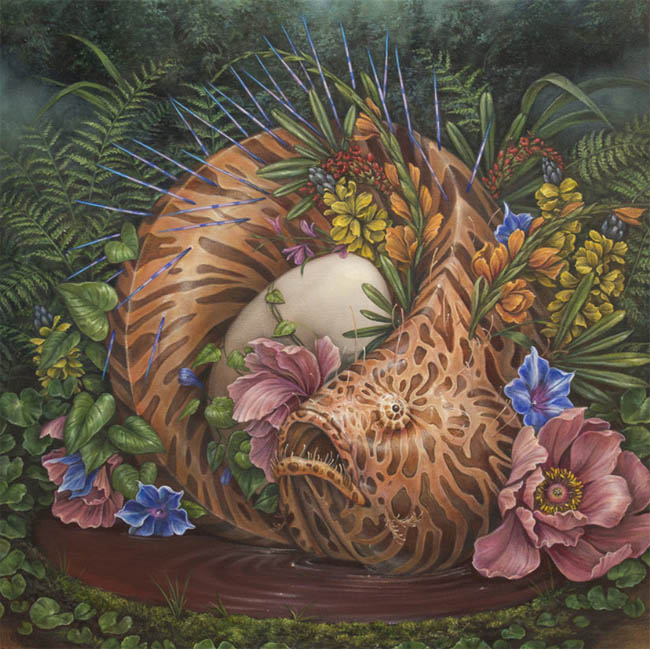
Hannah Yata
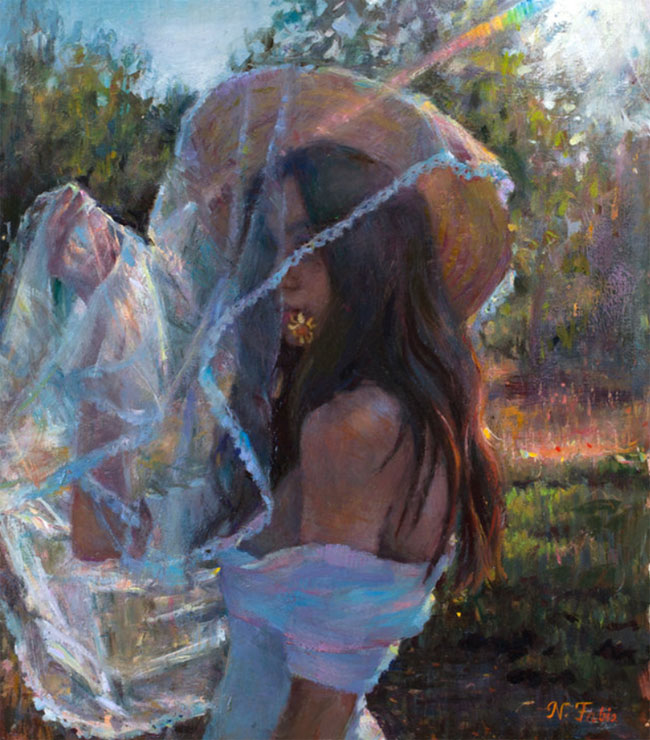
Natalia Fabia
Akiko Ijichi
How did you select the artists for the exhibition?
The exhibits I curate are entirely artist driven, meaning that I find inspiration in what the artists are doing and then the theme is built around that. I was particularly interested in artists who find beauty in the figure or in nature and express an overall sense of escapism that was characteristic of the romantics. I also wanted to have a little fun with the theme.
Erika Sanada
How many works are in The New Romantics show? Could you tell us about some of the works in the show and share some of the artist’s ideas behind their works?
There are 30 works in the show and it’s hard not to credit them all, but two I am especially drawn to are Adrian Cox and Miho Hirano’s. Adrian is a follower of Neo-Romanticism and we spoke a bit about it before I even started curating the show. His painting continues the romantic narrative of Adrian’s characters, the Border Creatures. He shares, “I wanted this painting to capture a sense of calm and peace, hinting at a return to balance and tranquility in the Borderlands.” Miho Hirano shared with me that her piece translates feelings of loss she has experienced in her life: “Grief flows with the meteor shining in the night sky and the figure looks ahead for a new dawn to come. I projected my feelings of hope into this piece, where the swallow is a messenger bringing it to me.” It reminds me of the quote, “I don’t think of all the misery, but of all the beauty that remains.”
Adrian Cox
Miho Hirano
What do you hope the audience will take from the show?
With any show that I curate, I always want to engage the audience and open their mind to new ideas and enjoy what they’re looking at. Art audiences have so many options when it comes to their entertainment and it is up to us to make sure our shows are evolving. This is a movement that is constantly evolving and in light of what’s going on in the world, the timing for a show like this felt right.
Dilkabear
You have a solid background in the Visual Arts with a varied experience. You have a BA Fine Arts and have worked as a creative consultant for major brands Hasbro and Saban, you ran your own business as an artist agent and you have been writing for Hi Fructose for two years. What have these experiences brought to your role as a curator for a major gallery?
Well, when you say it like that (smile) I have certainly taken a lot of steps forward and some false starts before I hit my stride. More than anything, what those experiences brought me is the people in my life and I believe we are defined by the people we keep around us. I have always surrounded myself with creatives and people with passion for what they do. I’m very lucky to have mentors in this space, other curators, who give me advice and support me. I credit Hi-Fructose for teaching me how to look at art and Hikari Shimoda, who I now manage and who is very philosophical, helped me to look at the world beyond the perspective of art. I think you need to be able to do both as a curator.
How do you see the role of a curator in general? Do you think it varies from gallery to gallery?
I can’t speak for other galleries, but this goes back to what I was saying earlier about our audience. Today’s curators can be informed and have expertise, but we’re a bit like educators and entertainers. Sure, it takes a special set of skills to put together an exhibition but it also has to be something that people want to attend. I want to curate an experience. My other obligation is to our artists, whether I’m offering them guidance on their shows or on their careers outside of the gallery. I know I’m not the only one.
Do you think there has been a rise of the ‘freelance’ curator putting together shows for galleries? If so why do you think this is?
I can’t say there is a rise in this idea of freelancing as a curator but I’m happy if more people are getting fired up about this line of work. For the most part, galleries have curators like myself who are on staff and doing this full time but we have also worked with outside curators and you don’t need to be attached to a gallery to curate. There is always a place for curators who are open and embracing fresh talent and leading the way to change.
As a curator for CHG your role is to ‘define the gallery’s growing program of artists’. Can you tell us about this role and what it involves? Are you on the constant lookout for ‘new talent’ and how do you go about this? What advice would you give artists who are trying to be seen by curators and gallerists? What is the best way for them to establish themselves?
Absolutely, I am always on the lookout and I find new artists everywhere. I travel constantly and go to as many shows and fairs as I can. This year, there’s been a lot of trips to New York and Tokyo, so you’ll see a lot of those artists popping up in our shows. Social media has certainly changed the game for galleries and has opened me up to more artists. This also comes with its downsides. I would advise artists to watch what they say and post online because no amount of great work will compensate for a bad attitude and you never know who is looking. Spamming a curator with your art in a DM or in “tags” is also not the way to go. Most galleries will list their submission policy or at least their contact information. Curators do this job because we are passionate about art and we love meeting new artists. Ask questions, work hard, be kind, and you will get there. I have this saying, “Don’t follow your dreams, follow your effort.” Dreams don’t work unless you do.
What do you love most about the role of curator and what do you find most challenging?
What I love and what I find challenging is always the same, and that is there is no such thing as a typical day.
Caro Buermann (left)





